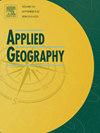Understanding the spatiotemporal response of dockless bike-sharing travel behavior to the small outbreaks of COVID-19
IF 4
2区 地球科学
Q1 GEOGRAPHY
引用次数: 0
Abstract
While the impact of the COVID-19 pandemic on human mobility is widely studied, the effects of small outbreaks remain underexplored. This study addresses this gap by investigating spatiotemporal behaviors of dockless bike-sharing (DBS) over small outbreaks. First, descriptive statistics and network theory are applied to identify the spatiotemporal evolution across different outbreak phases. The Prophet model is then introduced to evaluate short-term responses, and the copula theory to analyze behavioral preferences. Results indicate increased count and decreased duration during small outbreaks, contrasting with broader pandemic observations. Although DBS activity is most localized during the outbreaks, it expands eastwards into wider urban peripheries, showing community merger and growth. Notably, network communities reveal distinct spatiotemporal behaviors compared to grid-based analysis, offering new perspectives for targeted strategies. Travel behaviors vary with rising cases within a week: trip count initially increases, then declines in the urban core, while trip distance and duration shorten in over half of the region. Probabilistic modeling, however, suggests that greater distances are more likely on days following new cases in western Shenzhen, highlighting the need for comprehensive analysis. This research provides multi-level spatiotemporal insights into bike-sharing behavior for stakeholders in urban and transport planning.
求助全文
约1分钟内获得全文
求助全文
来源期刊

Applied Geography
GEOGRAPHY-
CiteScore
8.00
自引率
2.00%
发文量
134
期刊介绍:
Applied Geography is a journal devoted to the publication of research which utilizes geographic approaches (human, physical, nature-society and GIScience) to resolve human problems that have a spatial dimension. These problems may be related to the assessment, management and allocation of the world physical and/or human resources. The underlying rationale of the journal is that only through a clear understanding of the relevant societal, physical, and coupled natural-humans systems can we resolve such problems. Papers are invited on any theme involving the application of geographical theory and methodology in the resolution of human problems.
 求助内容:
求助内容: 应助结果提醒方式:
应助结果提醒方式:


